Hazel trees provide a vital source of food and shelter for a wide variety of animals, plants and other organisms, including 21 species of fungi and several rare species of lichen, liverwort and moss. Over 250 species of animal also feed on the seeds, leaves, flowers, wood and bark of hazel trees. Trees in general are such an important and vital part of our ecosystem, as they create oxygen, soak up carbon dioxide, prevent soil erosion and retain nutrients in the soil as well as providing food and shelter for humans and wildlife. Even when an hazel tree dies it still plays a vital role in the ecosystem. The dead wood creates nitrogen for the soil and provides habitats for a variety of animals.
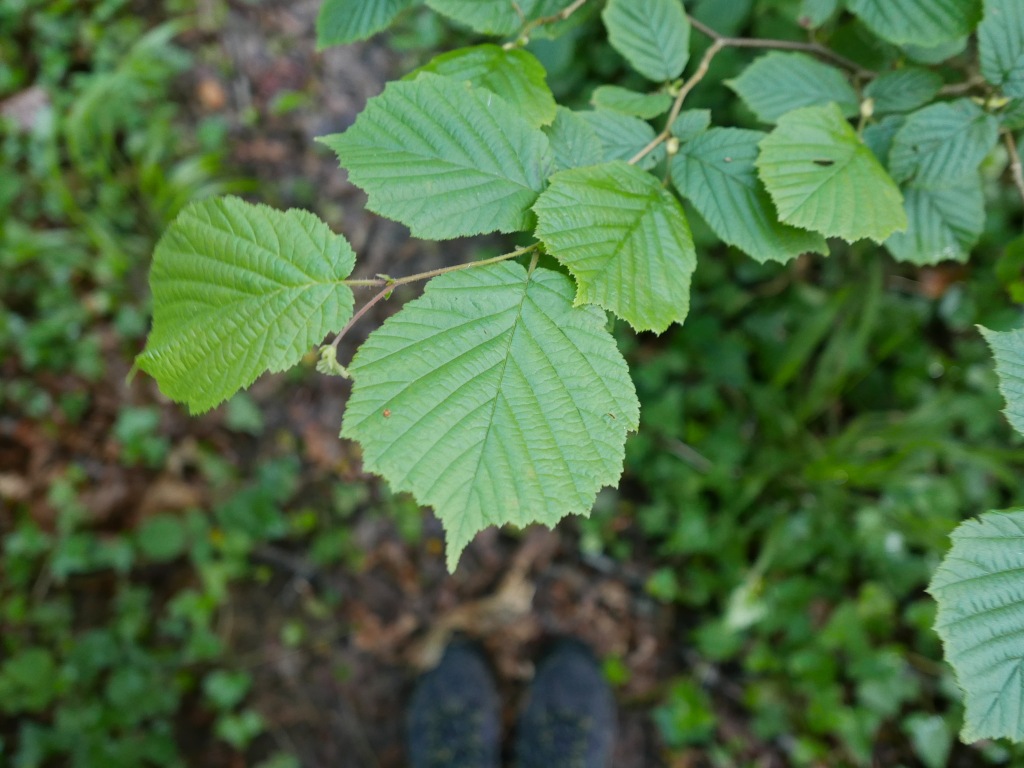
Hazel trees are most easily identified by their soft green leaves which are oval shaped with pointy tips and downy hairs on the underside. The bark of the tree is mostly smooth, shiny brown with scatterings of paler flecks and bumps. Hazel trees are deciduous which means they start to lose their leaves in autumn and then grow new ones in the spring. They also grow flowers called catkins in the spring, the female hazel catkins appear on the branches as small scaly buds with star bursts of red stamen whereas male catkins grow as long dangling, clusters of pale yellow flowers. Hazel catkins don’t actually produce any nectar as the trees themselves are wind pollinated, but the pollen they do produce does still provide an important source of food for bees and hoverflies early in the year.

Once pollinated the female catkin buds will start to develop and form into the brown hard cased seeds we call hazelnuts (they are also sometimes known as filberts). Hazelnuts are rich in calories and essential nutrients like Vitamin E, Thiamin, Magnesium, Copper, Manganese, Vitamin B6, Folate, Phosphorus, Potassium and Zinc. Hazelnuts provide a rich source of food in autumn and winter for mammals like dormice, wood mice, roe deer and squirrels as well as a variety birds like woodpeckers, nuthatches, tits, wood pigeons, jays. Dormice especially rely on the calorie rich hazelnuts to fatten up themselves up for hibernation over the colder winter months, with several other animals also gathering and storing hazelnuts to sustain themselves when food is scarce.
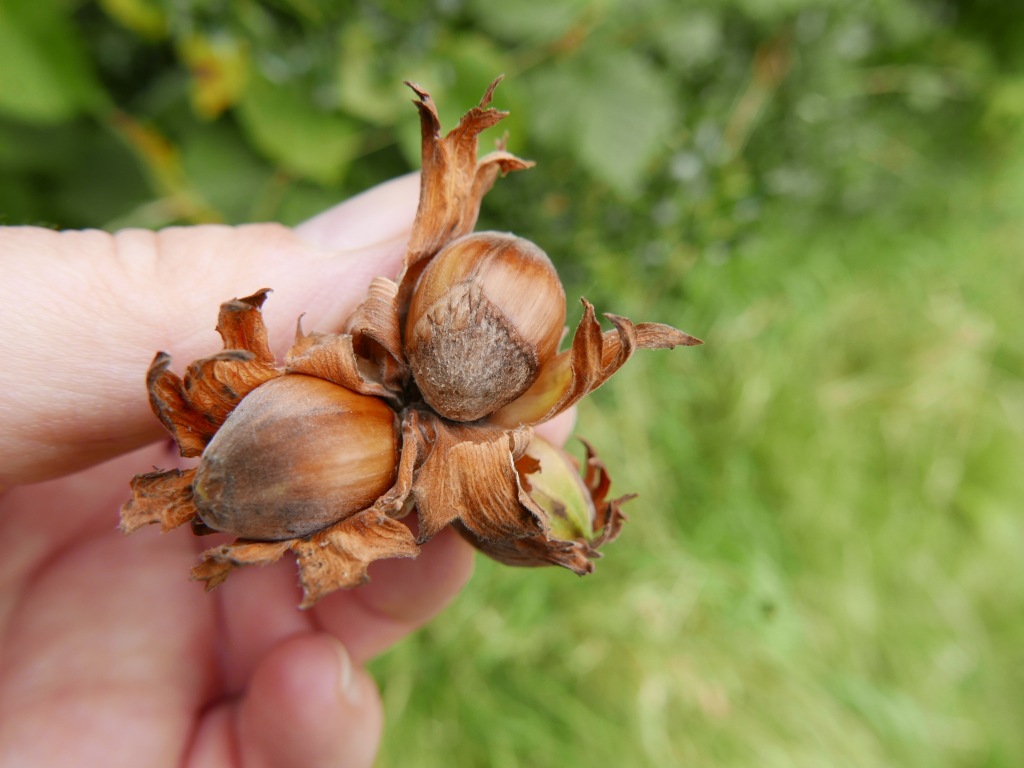
In spring dormice and nesting birds also rely on the many species of caterpillar that feed on hazel leaves, as food for themselves and their young. Hazel leaves and trees also provide safe egg laying spaces and food for hundreds of species of butterflies, moth, beetles, bugs and flies, as well as nesting sites for birds.
Throughout history humans have also relied upon hazel trees for food, shelter and building materials. Humans have been eating Hazelnuts since pre-historic times and they where considered an important source of food before the cultivation of wheat. The ancient Greeks and Romans both cultivated hazel trees for food and materials and up until the 1990’s hazel trees were grown in the UK for large scale hazelnut harvesting

Hazel trees produce slender, bendy, flexible branches that can be twisted woven, knotted and intertwined together. This makes hazel an incredibly useful material for crafting, constructing and building with. Historically hazel branches have been used to make roofs, furniture, fences, baskets, boats, decorations, tools, walking sticks, stakes and poles.

Hazel trees have been coppiced for wood by humans for over 4000 years. Coppicing is the practice of cutting and pruning certain types of tree down to the ground so that only the base of the trunk remains. Some species of tree like hazel regenerate after coppicing, quickly growing new branches, limbs and leaves. Surprisingly an un-coppiced hazel tree will only live up to 80 years, where as a coppiced hazel tree can live for several hundred years more. Coppicing hazel has actually become an important tool in managing and conserving woodland habitats, as coppiced hazel also providing shelter for ground-nesting birds as well as open, wildflower rich habitats for several species of butterfly.
You can find lots of easy hazel activity ideas below to help you learn more about these amazing trees!
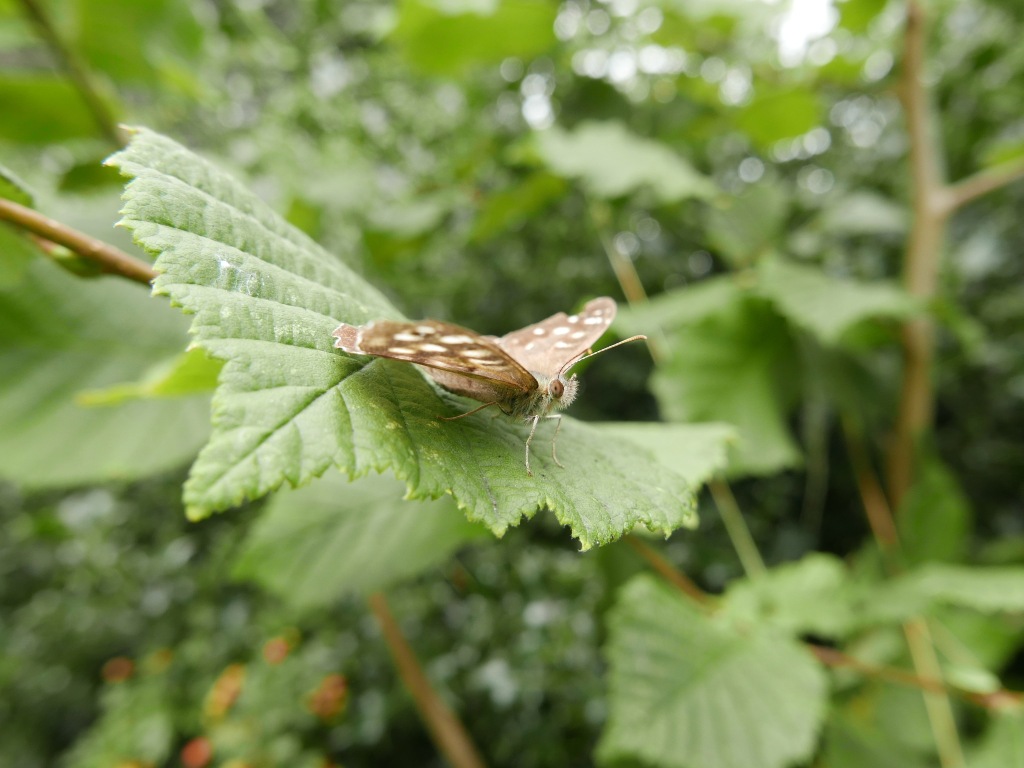
1. Go on a hazel wildlife safari
You will often find pollinating insects like bees and hoverflies on or around hazel catkins in the spring feeding on the pollen. The tops and undersides of hazel leaves are also often teeming with insects, eggs, caterpillars and larva that you would normally overlook. It’s the perfect place for them to shelter away from predators, wind and rain as well as often providing a source of food. You could take a notepad or camera with you to record your finds. You can also help citizen science by recording any minibeasts you find on national databases like Nature’s Calendar or iRecord.
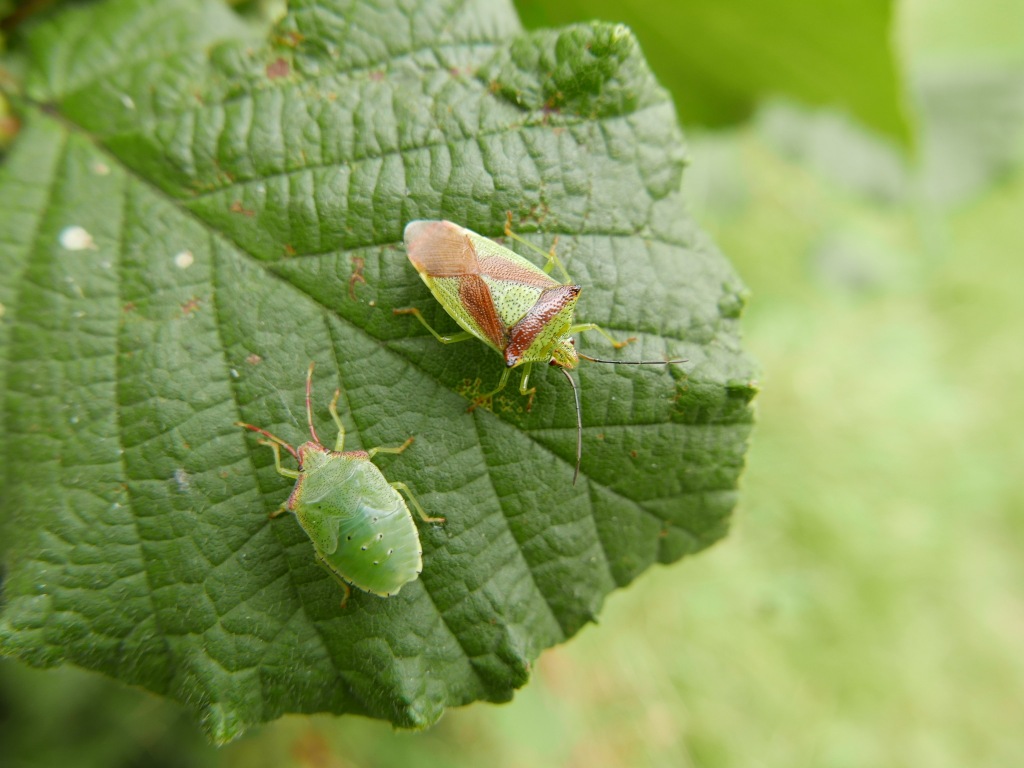
2. Look for Nut Leaf Blister moth larvae
Nut Leaf Blister moths lay their eggs on the top sides of hazel leaves so their larvae can feed on the leaves when they hatch. As the larvae feeds on the leaves it creates a distinctive blister on the leaf surface which is very easy to spot. Nut Leaf Blister moths are one of the few species to feed on the top sides of hazel leaves. Again you can help citizen science by recording any moth larvae finds on national databases like Nature’s Calendar or iRecord.
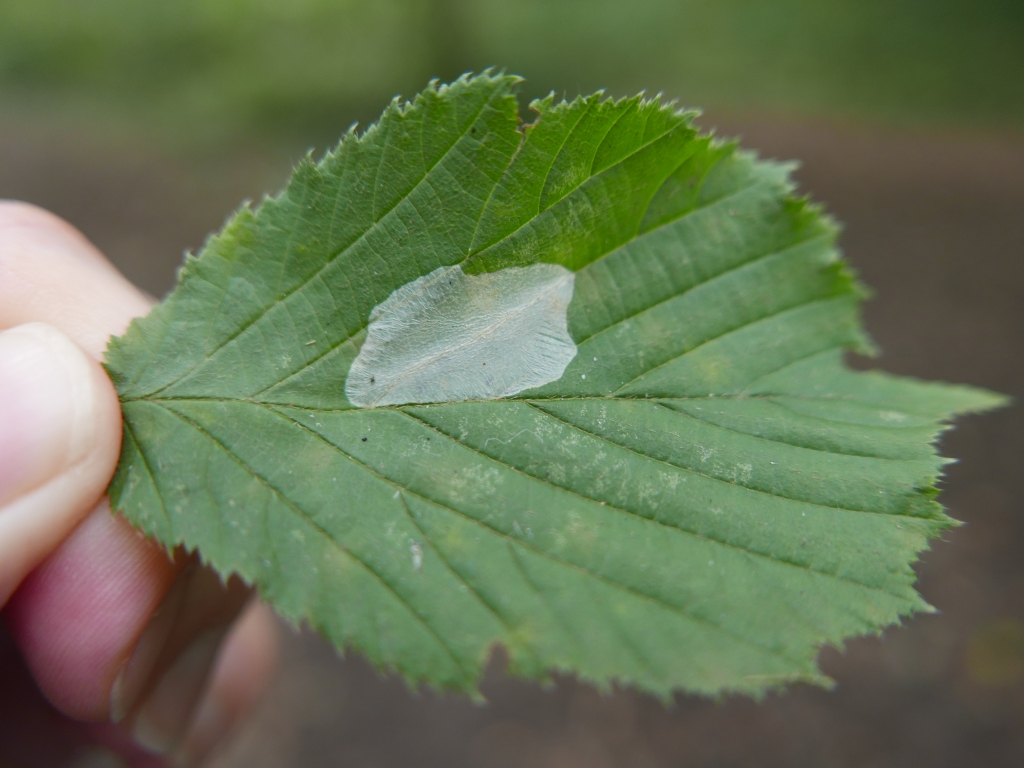
3. Shake pollen from hazel catkins
Most plants form seeds by pollination, the flowers contain ovules (structures containing female reproductive cells) which need to be pollinated before they can then develop into the ‘fruits’ that contain seeds. Hazel trees are wind pollinated which means the pollen is blown and carried by the wind from one tree to the next. You easily see and explore the pollen dust (male) hazel catkins create by shaking and tapping the flowers against your hand on a dark surface.
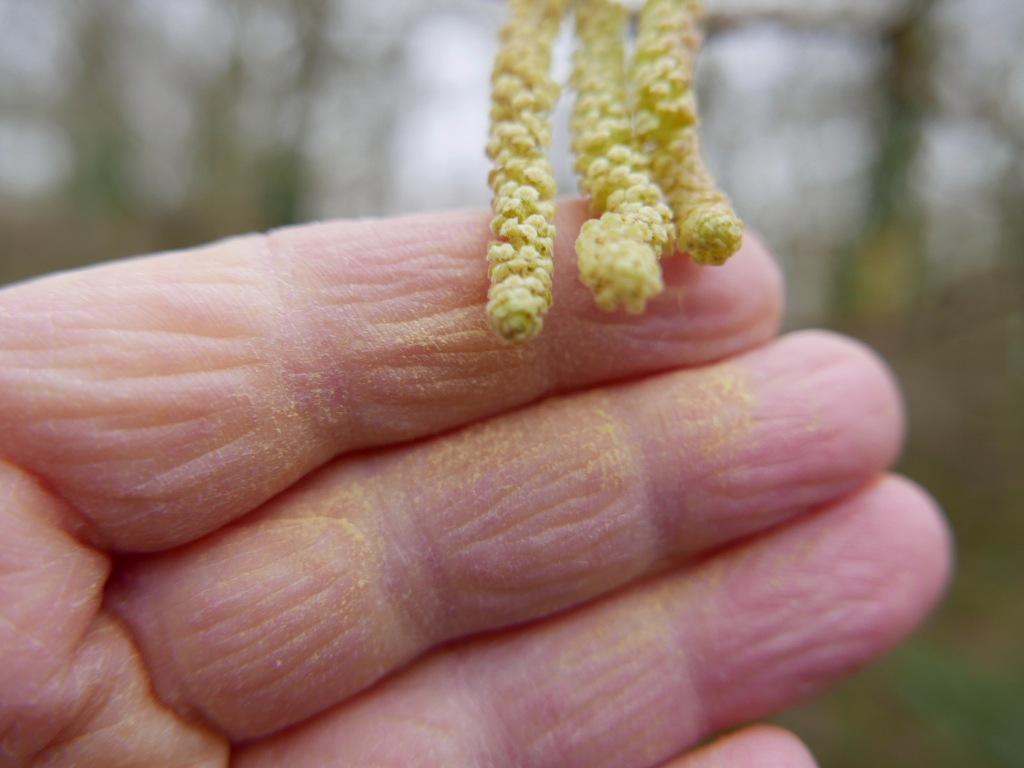
4. Watch hazelnuts form on trees
Overtime plants have evolved a variety of different and specialized techniques to release and spread their seeds as far and as wide as possible giving them a greater chance of survival and success. Some seeds are designed to be carried on the wind, some are released with explosive popping forces, others hitchhike by sticking or hooking onto passing animals and a variety of others rely on being eaten. Hazelnuts are often collected and buried in the ground by animals storing them for the winter, however any left in the ground by spring will start growing into trees.

You are very unlikely to find ripe hazelnuts on the trees when you are out and about in the autumn as a squirrel or other wild animals will already have found and collected them. However you can find newly developing hazelnuts on trees at the end of spring and watch them grow and over the summer. If you are ever lucky enough to find ripe brown hazelnuts then you can eat them raw or enjoy baking with them.
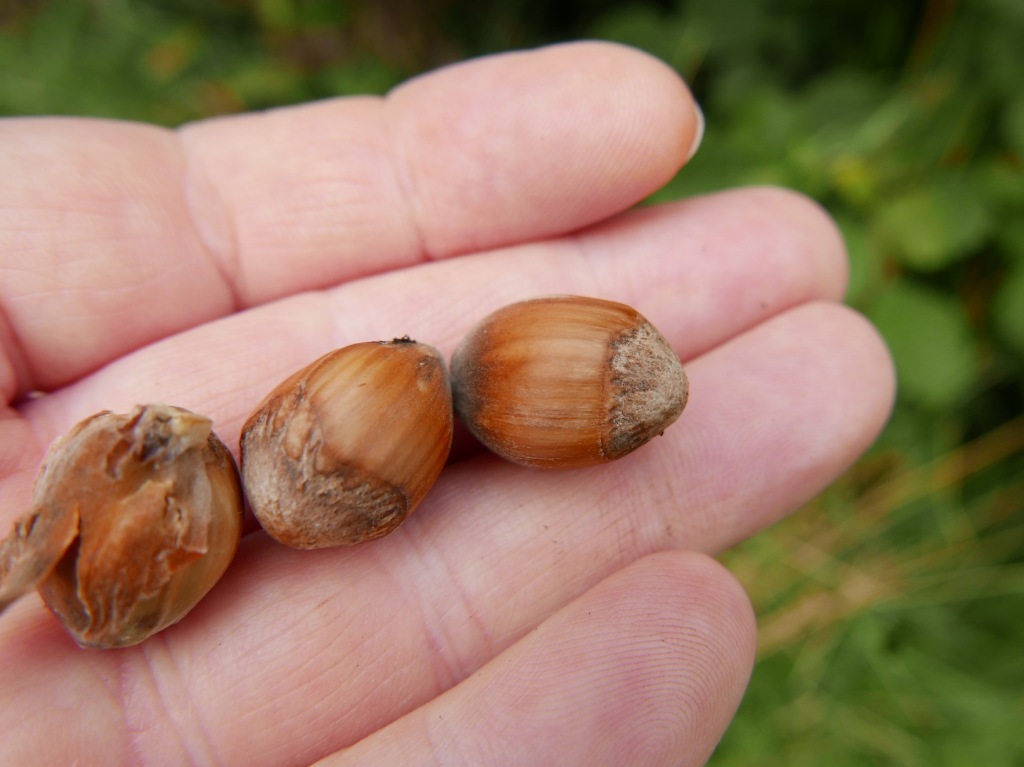
5. Become a hazelnut shell detective
You can often find hazelnut shells around hazel tress or on woodland walks during the autumn and winter. If you look closely at them you can play detective and try to work out what animal has eaten the hazelnut. If the nut has been split neatly in half then it is most likely to have been eaten by a squirrel. If there is a hole in the shell that is ragged and has tooth marks across the surface and edges of the nut then it was mostly eaten by a wood mouse, if the hole is smooth round and has tooth marks on the inside of the hole but not the surface of the nut then it was most likely eaten by a dormouse or a bank vole. If the nut is broken into pieces or jammed into a tree crevice then it was most likely eaten by a bird like a woodpecker or nut hatch.

6. Grow a hazel tree
The best way to learn how hazel trees grow is to plant a hazelnut. We have had a lot of success growing hazel saplings from hazelnuts, you just simply need to collect a fallen hazelnut or pick a nearly mature hazelnut from a tree on a walk in the autumn. Next make a hole in a pot of earth or directly into the ground to plant the hazelnut in. Don’t forget to then water your hazelnut regularly and then patiently wait and watch for the first shoots of the sapling to emerge in spring. You may never see the fully grown tree Hazel tree as you will have probably moved home long before then. But by planting the seeds you are providing wildlife with a future source of food and shelter. It reminds me of a wonderful quote “A society grows great when old men plant trees whose shade they know they shall never sit in.”

7. Go forest bathing under hazel trees
Forest bathing (or shinrin yoku) is the Japanese practise of being calm and quiet amongst trees, breathing deeply and observing the natural world around you. Being able to connect with nature is so important for our physical and mental well being. Many studies have shown that spending time outdoors in nature helps lower levels of anxiety, stress and depression in both adults and children. It is especially useful for helping children to calm themselves down and regulate their emotions.

To forest bath you simply need to find a comfortable place to sit or stand amongst some trees. Close your eyes take a few deep breathes and listen to your heart beat. Slowly tune into the environment around you by focusing on one sense at a time. feel the air on your skin and the grass or ground beneath your feet, listen to the sounds around you from rustling leaves to running water, can you smell the flowers, plants and grass. Take a few more deep breaths and open you eyes, look at the colours, patterns and textures around you. Can you see any insects, birds or signs of movement around you? What shapes are the clouds? Find a tree or plant and explore the different textures of bark or leaves, run your hands through grass or water engage all your senses.

8. Make hazel leaf boats
Making leaf boats and nature rafts is such a simple and fun activity that encourages creativity in children of all ages and helps develop fine motor skills. All you need for this is some leaves and water to sail your boats on. You could use a puddle, pond, stream, river, lake or even just a bowl or bathtub at home. Safety note: Children should be supervised at all times around open water. Please be aware of the health and safety risks, rules and restrictions of any area you visit.

To make a leaf boat you simply need to push the stem of one leaf through the middle of another leaf, then carefully pull a tiny bit of leaf end through so it stands up like a sail, with the leaf underneath serving as the base of the boat. Now your boat is ready to set sail, just place it on some water and watch it float, it really is that simple! How about making multiple leaf boats and having a boat race. Or you could experiment with pushing the leaf boats across still water by blowing or fanning air onto the sails.
9. Hazel bark and leaf rubbing
A great activity for on the go. Simply place a sheet of paper over the trunk, bark or leaves of a hazel tree. Then using the side of a a crayon or piece of chalk carefully rub over the surface of the paper to pick up the textures and patterns of the hazel bark or leaves underneath.

10 Hazel leaf crowns
The easiest way to make a leaf crown is by using a band of paper or recycled card. Simply cut two strips from the paper or card and attach them together so you have a band long enough to fit your head. Place a strip of double sided tape across the band. Then all you need to do is peel the backing off and stick hazel and other leaves to the surface. If you leave the double sided tapes backing on, then you can take your bands out about with you on walks. Then you can decorate your crowns on the go using natural materials you find on your walk.

11. Hazel Nature Painting
Nature painting is a simple activity for children of all ages, Just dip hazel branches, leaves or catkins into paint and use them as natural paintbrushes or paint, print and mark make with. How about experimenting with other different natural materials to see what variety of marks you can make by using different shapes and textures. You could also paint directly onto the leaves to decorate them. Or lay the leaves onto paper or cardboard and then paint over them to capture the interesting outlines. Recycled cardboard is a great environmentally material to use instead of paper. Simply cut out panels from old cardboard boxes and packaging.

12. Hazel tree collages
All you need to make a hazel tree collage is some recycled cardboard, double sided tape or glue and some hazel leaves. Simply draw or cut a tree shape on or out of the cardboard. Then you can stick or glue any leaves, bark or sticks that you find on a woodland walk onto your tree.
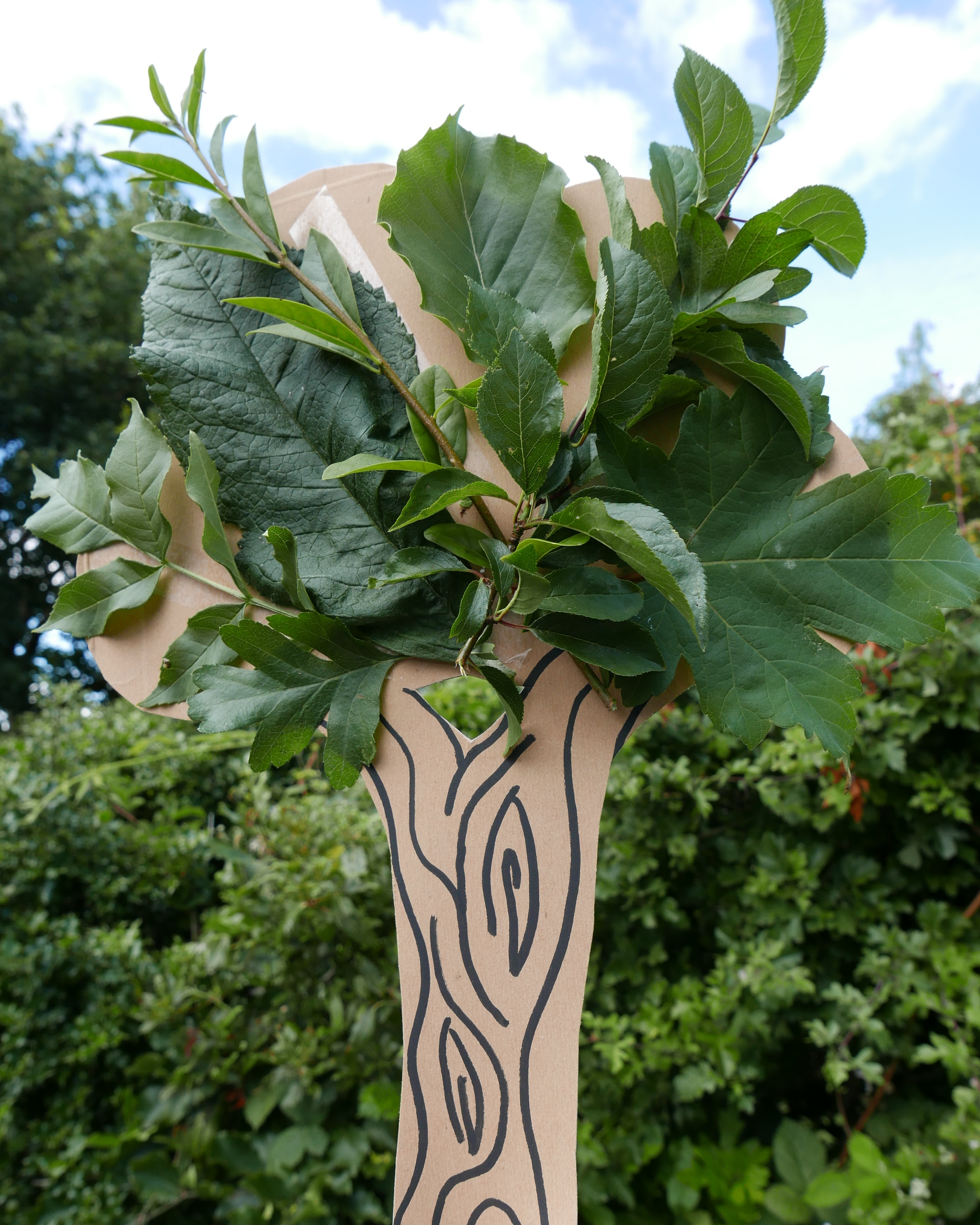
13. Hazel leaf and land art
Nature art (also sometimes called land art) is a wonderful nature activity that encourages creativity and fine motor skills in children of all ages and abilities. All you need is some imagination and natural materials to make pictures, shapes and patterns or letters, numbers and words. You could use leaves, stones, grass, bark, twigs, fallen fruit, nuts and seeds and flowers. *But pretty please don’t pick any wild flowers, only collect ones you have grown yourself or fallen ones you find on the floor.

It’s easy to make simple patterns and shapes with leaves and sticks like spirals, hearts and smiley faces. Or you could be more adventurous and try to make a picture or story scene. How about making a stick and leaf butterfly or a leafy caterpillar. Once you have finished you could glue the leaves onto paper or card or take photographs and turn them into cards or artwork.
14. Hazel potato prints
Potato printing is a simple activity for children of ages, all you need is a potato cut in half, a bit of inspiration and some paint to get started. How about using the prints to make patterns, pictures, cards and even recyclable wrapping paper. It is also fun to experiment printing on different types of surfaces and textures from paper to fabric, foil and wood. And as long as you use non toxic paint you can even print on outdoor surfaces like paths, trees and leaves

Hazelnut and leaf potato prints are fun and very easy to do. For Hazelnut prints you just need to cut half of a potato into a tear drop like oval shape, then dip it in brown paint and print it onto a surface. To make hazel leaf shaped prints you will need to cut one end of a potato half into a triangular point. Then carefully cut a line down the centre of the potato half with two or three lines branching out on either sides. Finally then dip it into green paint and print it onto a surface.
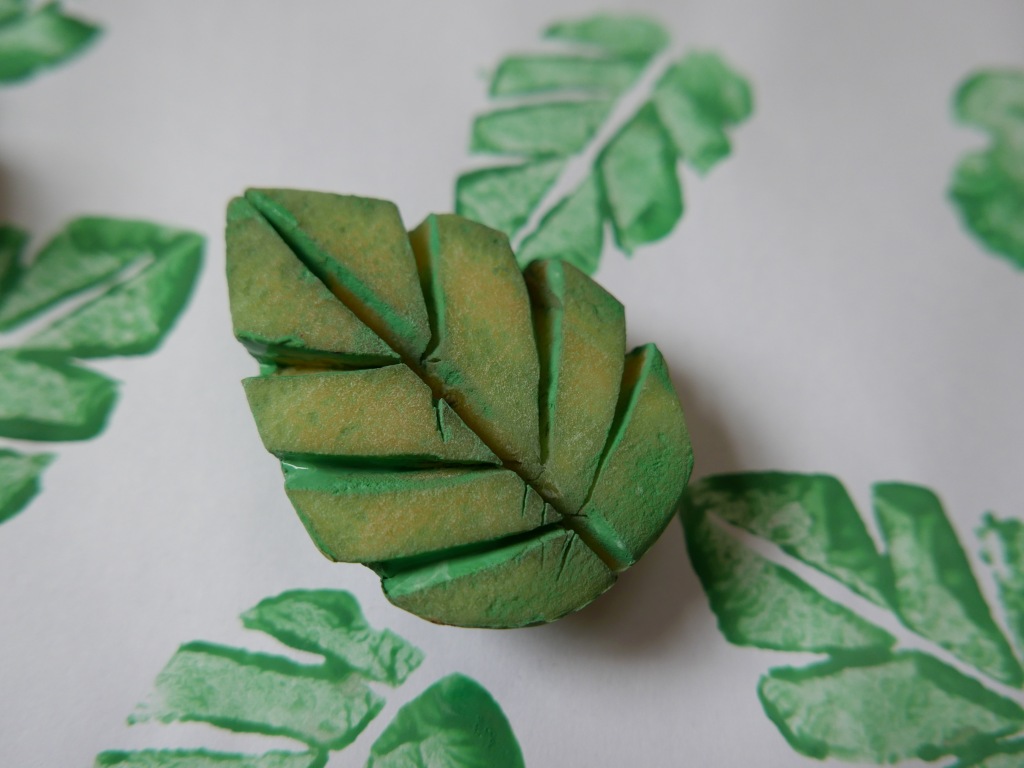
15. Hazel hoops
You can easily make natural wooden hoops using bendy young hazel branches (willow branches also works well for this). Carefully bend and then twist the ends of a branch together to form a hoop. Then twist and wrap additional branches round the hoop until it is study enough to form a hoop. Please ask the land owners permission first before taking any living branches off trees.

16. Hazel wreaths
You can also turn your hazel hoops into seasonal wreaths using any natural material you find. The branches and leaves of ever green trees often last the longest. Some natural materials that work well include Ivy, Fir, Pine, Spruce, Magnolia and Cedar. You could also use pine cones, dried flowers or seed heads. Just be careful using holly with smaller children because of the spiky leaves and toxic berries.

17. Hazel journey sticks
Journey sticks are a great way to engage children of all ages in the natural world. All you need to make a journey stick is a fallen hazel stick or short branch and some old string, wool or ribbon to wrap around it. The children can then collect interesting natural items* they find on a woodland walk and thread and weave them onto the stick as they go. Don’t forget to talk about all the things you find along the way. *Please don’t pick any wild flowers, only collect ones you have grown yourself or fallen ones you find on the floor.

18. Hazel stick people
Making stick people and woodland figures is a fun and easy activity for children of ages where you can use any hazel sticks and branches you find to create fun and interesting characters. You can easily bring the sticks and branches you find on walks to life by giving them faces and different expressions using just marker pens or paint.

Older children and adults could also remove the bark at one end of the stick or branch using an old vegetable peeler (Adult supervision required) or sand paper to create a smoother surface to paint and draw the faces onto. You could also give the figures hair and clothes using old wool, string, ribbon, strips of fabric or found natural materials like grass, leaves, bark, thin twigs, seed cases and flowers*. *But again please don’t pick any wild flowers, only collect ones you have grown yourself or fallen ones you find on the floor!
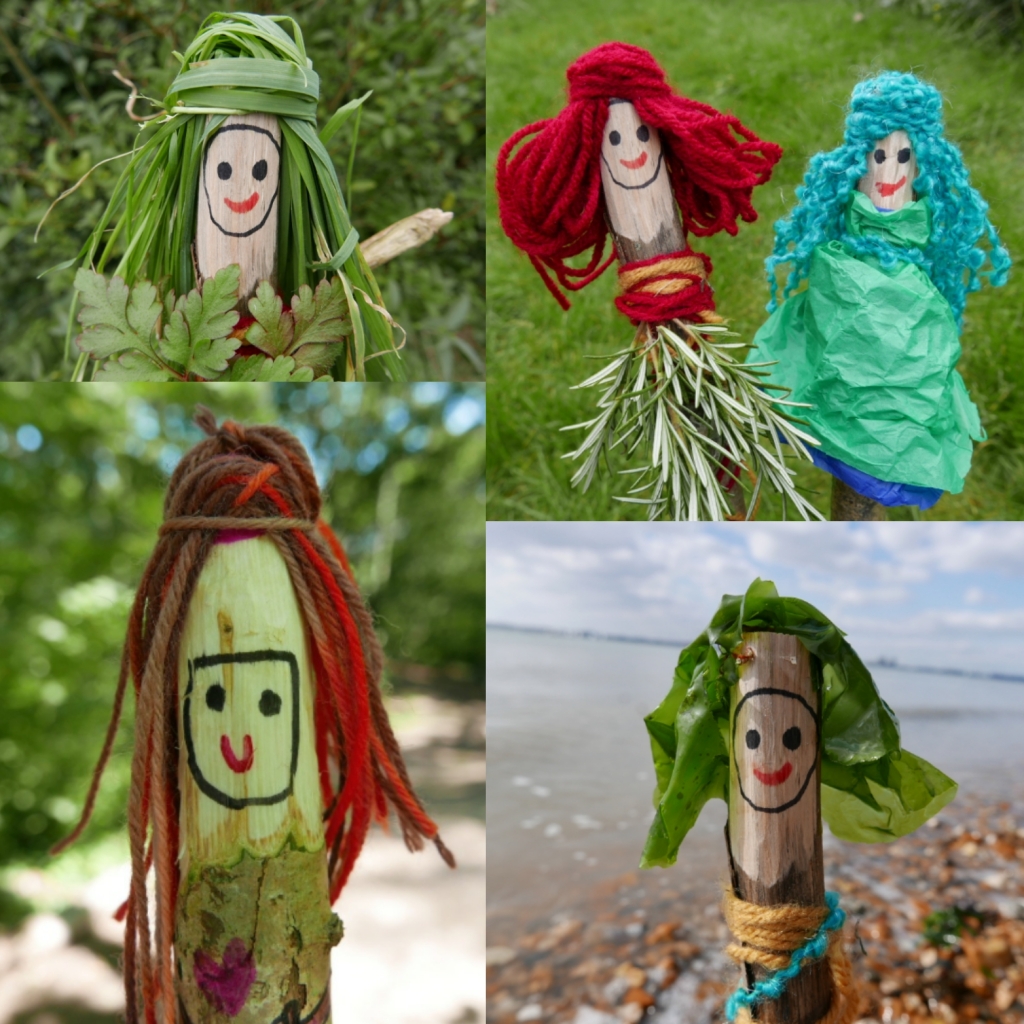
19. Hazel tree spirits and guardians of the wood
It you have some clay you can have fun making tree spirits or guardians of the wood using natural clay and any natural materials you can collect and find. (Please don’t use salt dough or play dough for this instead as both contain high volumes of salt which is toxic to trees, plants and wildlife) Simply press the natural clay onto the trunk of a tree and shape it into a face. Then press some natural materials into the clay to give your spirit features like eyes and ears or a mouth and hair. You could use leaves, stones, grass, bark, twigs, fallen fruit, pine cones, acorns and flowers. *But pretty please don’t pick any wild flowers, only collect ones you have grown yourself.
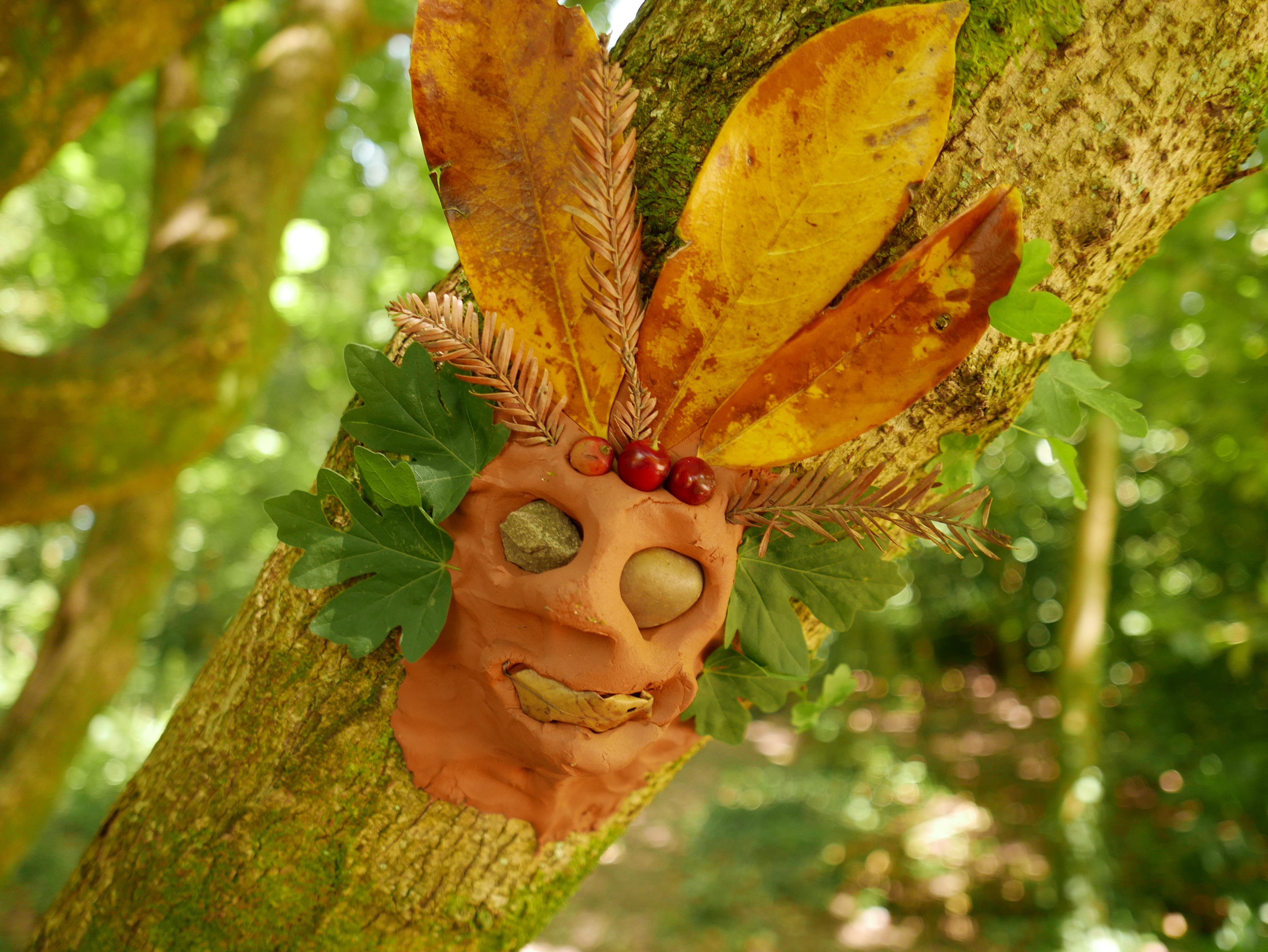
20. Tataki zome
Tataki zome is the Japanese art of transferring botanical dyes from flowers and leaves onto fabric by simply hammering them onto the surface. It’s also know as flower pounding, leaf bashing and sometimes refereed to as Hapa Zome. (Funnily enough Hapa Zome came from an artist getting the name wrong, now its more widely used than Tataki zome which is the correct name for it.) For this activity you will need scraps of cotton or linen fabric or some old clothing. something to hammer with like a rounded stone, hammer or rolling pin, a safe surface to hammer on and finally natural botanical materials like hazel leaves.
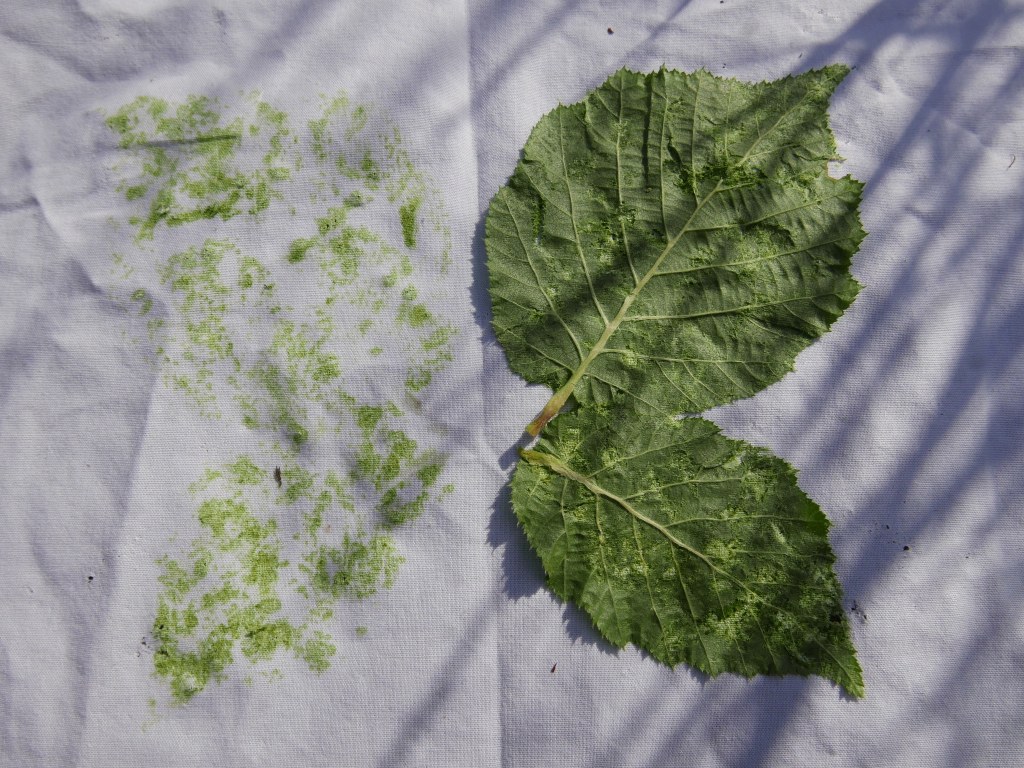
Lay the fabric or clothing flat onto a hammer safe surface and arrange your flowers and leaves on top. Then cover everything with a piece of paper or another piece of fabric. Carefully but firmly (supervision required at all times for this) hammer across the fabric with a stone or hammer. You should be able to see the dye seeping through the fabric so make sure you have hammered evenly across. Peel back the paper to see the images you have made.
For day 5 of 30 days wild 2024. We enjoyed a woodland walk, planted a hazel tree we had grown from a hazelnut in the garden, made leaf crowns, decorated hazel log slices and enjoyed some Tataki zome.
If you like this you might like to try:
Elderflower recipes and Elder tree activity ideas

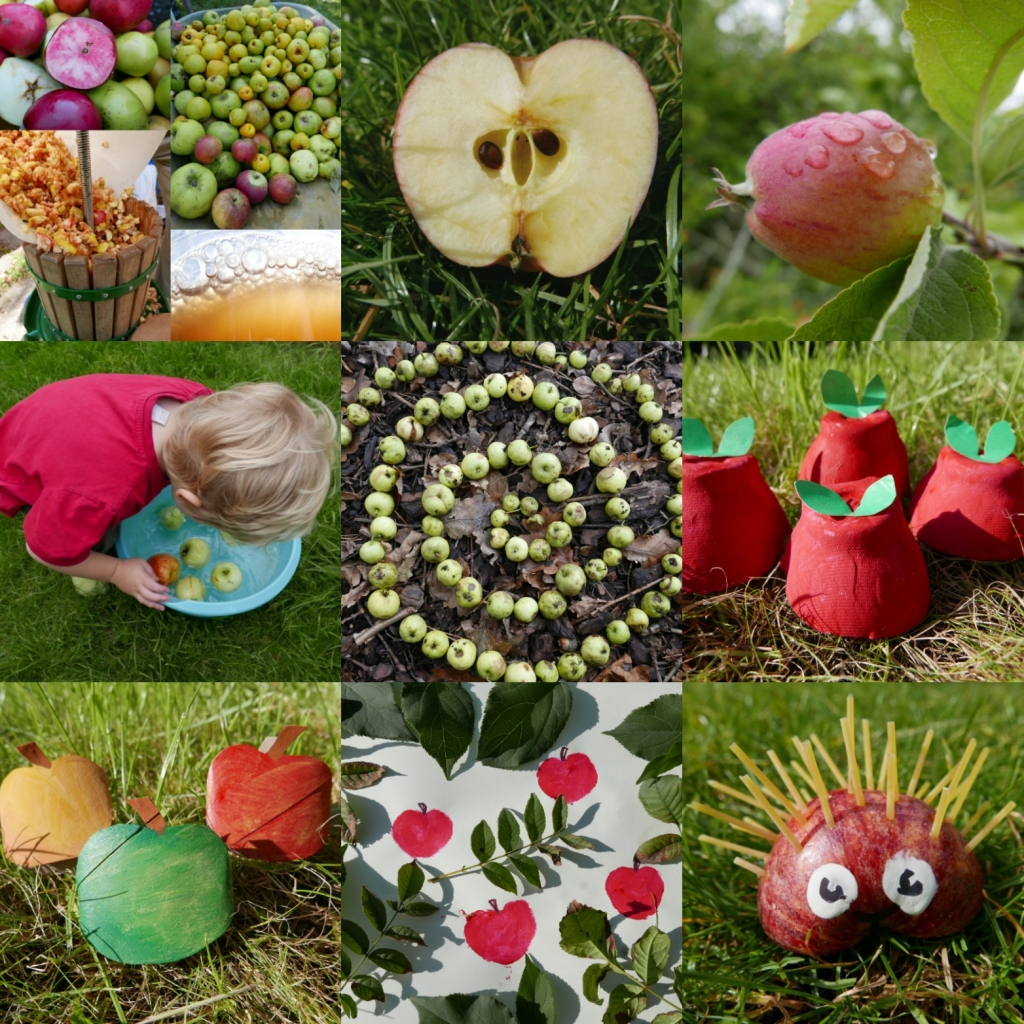



One thought on “20 Hazel tree activity ideas”